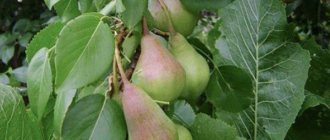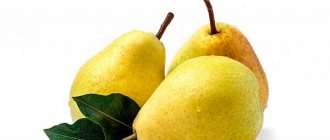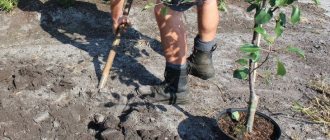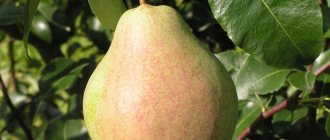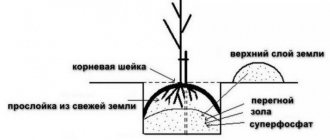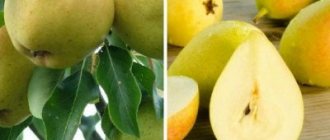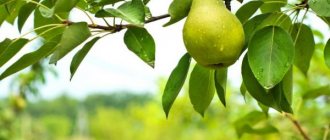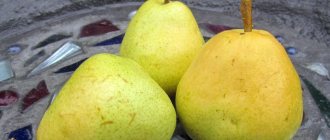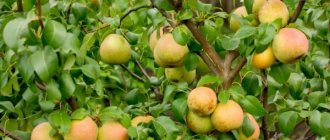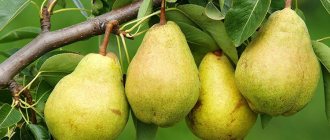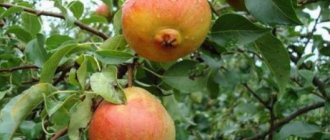Loading…
Loading…
Severyanka (severyanka red-cheeked) was bred through the hybridization of 2 varieties in 1959 by Yakovlev P.N. Pear Severyanka, description and photo, the plants of which are given below, were bred specifically for the northern regions, from which, in fact, it got its name. Today, pear is widespread in the Ural region.
Description of Severyanka pear
You should take a closer look at the appearance of the fruit and tree.
The tree is small in size. The northern red-cheeked pear reaches its maximum height only at the age of 14, while its height is about 6 meters. It grows quite rapidly in width.
In addition, it has a wide trunk and strong branches. The diameter of the tree quite often reaches more than 6 meters. And its top has a pyramidal shape. The branches have a small thickness and medium density. They are firmly attached to the main shoot, and are deflected to the side at a large, almost right angle.
The bark is dark in color, but its color can vary from brown to gray.
Its foliage is dark green. They are medium-sized, oval-shaped and have distinct sharp tips. And their plates are straight without bends with jagged edges.
Its inflorescences are medium in size and white in color. They are collected in groups of 6 pieces, and are similar in shape to saucers. And their peduncle is quite long.
A characteristic feature of the inflorescences is that they are resistant to low air temperatures. And they bloom early - in April and May.
The stems are brown and medium thick. Moreover, they have practically no bends. The kidneys also have sharp endings. In addition, the tree has high rates of stem formation.
The fruits of this variety are small in size. But still quite often they are below average in size. The average fruit weight is about 120 grams.
The shape is oval, and the peel is smooth, compacted and not rough. During harvest, the fruits are light yellow in color, and yellow-green can also be found. But in some places this color can turn red only if they hang on the sunny side for a long time.
But this redness is distributed like spots or streaks, thanks to which the variety acquired its name - Severyanka red-cheeked.
The flesh inside is cream colored and quite juicy. The seeds of the fruit are large, brown in color and ovoid in shape. The fruits taste sweet, but you can still notice a hint of sourness. And their smell is quite pronounced.
The plant will begin to bear fruit 5 years after planting. The fruit ripens in the summer around mid-August. In this case, the fruits must be consumed within two weeks.
The yield of an eight-year-old tree is approximately 120 c/ha. The seedling is selected when it is up to 2 years old, and its height reaches 160 cm.
In addition, it has high frost resistance rates, which are only slightly inferior to Severyanka.
The variety has many advantages, which include early ripening, frost resistance, and it is also resistant to scab. It has an attractive appearance of the fruit and is universal in use. But the main disadvantages include the small size of the fruit.
Varieties
At first, the hybrid was called Severyanka Yakovleva. Over time, it was shortened, the pear bred by P. N. Yakovlev began to be called simply Severyanka. It was used in breeding work. When crossed with another variety, a new form, Severyanka red-cheeked, was obtained. A summer variety, the fruits ripen in mid-August.
Red-cheeked
A hybrid variety of fruit crop is successfully cultivated in regions with temperate and northern climates. The trees are frost-resistant and are practically not affected by fungi and bacteria. The fruits are medium in size, with a bright red blush and juicy, sweet-sour pulp.
Fruit characteristics
According to the description, the sora pear Severyanka Red-cheeked is conical in shape and resembles a light bulb in appearance. At the beginning of the ripening period, the fruit is greenish with a pink blush, gradually it becomes yellow. The skin is strong, but not rough.
On average, one pear weighs 80-100 grams, which is quite small for such a fruit crop. The pulp is sweet, juicy, not tart, delicately creamy in color, this variety does not have a pronounced aroma.
The seeds are located in chambers that are medium in size and take up little space.
Yakovleva
A productive variety. Fruiting occurs in the 3-4th year of growth. The fruits are medium-sized, yellowish-green with crispy flesh and a juicy, sweet taste. Fruit ripening occurs in the first ten days of August.
Fruit
The Severyanka pear variety is not distinguished by its large fruit. On average, one fruit weighs 80-85 g, which is lower than the average of other varieties
The maximum weight of a northern pear is 120 g.
Pears are truncated-conical in shape. The peel is dense and thick, but at the same time not rough. Wide and small saucer. The seeds are large and few in number. The color of the fruit at harvest is greenish-yellow with a slight red tan. After some time, the pear has a predominant yellow color with small splashes of green with a pink blush. The pulp is cream-colored and not dense. The fruit tastes juicy, not tart, crispy, with sweetish-sour notes. The aroma is not strong. The fruits contain 11.8% sugar and 0.38% acid. Pears can be used not only for eating, but also for cooking and canning.
Main characteristics of the variety
The tree is not too tall (maximum 6 meters), has a crown in the shape of a wide pyramid with a diameter of up to 6 meters. Density is moderate, growth is fast. The branches are at an acute angle relative to the trunk. The foliage is painted in a dark green shade. The bark is smooth and brown. The flowers are white. The inflorescence includes up to six flowers.
This variety is an early summer variety.
Severyanka survives even very severe frosts without problems (sometimes down to -50 degrees), therefore, it is very popular in the northern regions of Russia. It is worth noting that even after frosts down to -40 and above, only the above-ground part of the plant can die, while the roots remain viable. Drought resistance is average.
Suitable climatic conditions
The northern pear, reviews of which say that it is unpretentious, is widespread in the northern regions due to its resistance. The trees tolerate cold and harsh winters well. And in cases of very high temperatures and freezing, the shoots quickly recover and the tree continues to bear fruit.
Drought resistance is average. With scanty rain and lack of watering, the fruits become smaller and lose their taste.
Advantages and disadvantages
In addition to the positive aspects, the variety also has negative ones. Therefore, it is worth considering them more carefully.
The advantages of the variety include:
- Since the variety is distinguished by its frost resistance, it is well suited for planting in the northern regions of the country, which have a cold climate;
- The tree of the variety is small and compact, so it is suitable for growing pears even in a small area;
- Thanks to early ripening, you can enjoy fresh fruit as early as August;
- If you take proper care of the plant, you can harvest about 100 kilograms of harvest from one tree;
- The variety is resistant to scab;
- Fruits can be used for various purposes
And the disadvantages include the following:
- Most of the fruits fall off before the scheduled time, for this reason you cannot miss the harvest date;
- The fruits are quite small in size and do not have any outstanding taste;
- The variety needs to be watered regularly and abundantly, as it does not tolerate a lack of moisture;
- Due to the fact that the fruits cannot be stored for a long time and have poor transportability, they cannot be used for commercial purposes.
Planting Severyanka pear
To plant, you need to determine in advance the place where the tree will be located. This could be a section of the garden near its border, where there are no drafts or excess sunlight.
Optimal timing
The plant must be planted in early spring or mid-autumn. In the first case, the crop is still “sleeping” and will begin to take root depending on the planting date. In the second case, the pear will have time to take root before the harsh winter. Each gardener chooses the timing independently, taking into account the climatic characteristics of the region.
How to choose seedlings
Seedlings of the variety are selected with healthy roots and branches. Too long and short copies are rejected. Straight roots, correct branching structure and proportionality of the seedling are its main parameters.
Important! You can break one small branch to make sure that the plant is not frozen. A normal branch will have a lively appearance and will not break off in your hand.
How to choose and prepare a place
The seedling is planted in a pre-prepared hole, located away from other trees. If this is a pear orchard, you need to take into account the height and size of the plants. In the case of a summer cottage, the fact that the crop needs to grow separately, at a short distance from pollinators and without drafts, is taken into account.
The pit is prepared 1–2 weeks before planting using the following technology:
- dig a “funnel” up to a meter deep and up to 80 cm wide;
- lay two buckets of organic fertilizers;
- water with 2-3 buckets of water.
The plant is planted in a prepared place, sprinkled with soil, carefully tamped down and watered so that the soil around the roots is compacted.
Did you know? The strong wood of pear trees has long been used for fortifications and dams. Nowadays, researchers find elements of ancient dams made from this wood.
Distance between trees
The crown of Severyanka is wide, the tree needs a large feeding area and bright lighting. There should be no structures or tall trees at a distance closer than 5 m from the pear trunk.
Growing pears and caring for trees
For the Severyanka pear, planting and care involves almost the same actions performed for other varieties. Nurseries probably no longer sell seedlings, but you can find them on the market from private owners. Hobbyists who still have this variety propagate it by grafting. If you managed to buy a Severyanka seedling, then you immediately need to choose a suitable place for the tree:
- The tree loves loamy or sandy soil. Before planting, you need to add a large amount of humus to the soil.
- The pear tree does not like groundwater. If the layers are located above 2 m, the root system of an adult tree will become wet.
- The northerner loves sunlight and does not tolerate wind.
Attention! Two-year-old seedlings are optimal for planting. Trees take root better in new soil.
Planting time falls in April or late September early October. It all depends on the climatic conditions of the region. If severe frosts are observed in winter, then it is better to plant a pear seedling in the spring. Before autumn, the tree will have time to take root and will not freeze. The place for the seedling is prepared at least a week in advance. First, dig a hole measuring 80x100 cm. Two buckets of humus mixed with a bucket of fertile soil are poured onto the bottom. To this mixture add 200 g of fertilizer containing potassium, as well as superphosphate - no more than 800 g.
After purchasing a pear seedling, they begin planting it:
- First, a liquid solution is made from clay - mash. The roots of the seedling are dipped into it.
- The next step involves inspecting the crown. Long branches are shortened, and damaged ones are completely cut off.
- The seedling is immersed in the hole with its roots, a peg is driven in nearby and the tree is loosely tied to it.
- The root system is lightly sprinkled with soil, and then watered abundantly. When the water is absorbed, the soil will settle a little. The hole must be completely filled with earth, and the seedling must be tied more tightly to the peg.
When the pear is well rooted, the support can be removed.
The main action during care is considered to be pruning the Severyanka pear, and this should be done from the first days of the seedling’s life. If the tree was purchased without skeletal branches, then the trunk must be shortened with pruning shears so that a twig 90 cm high remains above the ground. If there are skeletal branches on the seedling, they are partially pruned. Leave twigs with three buds. Similar actions have been carried out for three years in a row. Further pruning of the pear is considered sanitary. Dry, frozen and damaged branches are removed from the tree. Be sure to trim the shoots.
Caring for a pear involves periodically loosening the soil around the trunk. This is necessary to provide oxygen to the roots. It is advisable to get rid of weeds immediately. They draw moisture and nutrients from the soil. Severyanka is a rather moisture-loving variety. The pear tree needs to be watered more often so that the soil does not dry out, but waterlogging should not be allowed. Once a season, the tree is fed with minerals. In autumn, humus is added to the roots. Before winter, it is important to water the pear abundantly and mulch the soil. This procedure increases the chance of the tree overwintering.
Rules of care
Once the seedling has taken root, caring for it is not much different from caring for any tree of the rose family.
Feeding and watering
It is necessary to water a pear tree, especially a large one like Severyanka Red-cheeked, abundantly and not only at the root. Normal watering consists of 5–6 buckets of barely warm water, poured around the perimeter of the crown projection 2–3 times a week.
They begin to feed the pear at 2–3 years, depending on how much fertilizer was put into the planting hole. During awakening, you can apply organic fertilizers, during flowering - phosphates, and when pouring fruits - potash.
Loosening and weed control
The need for weed control is a debated process. On the one hand, a clean garden gives a high-quality harvest, on the other hand, the grass in the near-standard part can act as mulch.
Loosening the soil near the trunk of the fruit tree is necessary to destroy the crust after watering. This must be done carefully so as not to touch the trunk and trunk roots.
Trimming
The formation of a pear crown is an important process. The tree can grow into itself, thickening the crown. To prevent this from happening, you need to carry out annual picking of branches. Those that are too long are cut in half, the rest can be shortened by a third.
Sanitary trimmings and treatments
During the process of sanitary pruning, all broken, damaged, frozen and improperly growing branches are removed, and the cuts are treated with garden varnish. Sanitary pruning of the plant is carried out in late autumn.
Rejuvenation
Young trees undergo sanitary and formative pruning. With age, the yield decreases and there is no shoot growth. To rejuvenate the tree, the crown is made more sparse. First of all, old, damaged branches are cut out. Remove shoots that grow inside the crown and are twisted. Heavy pruning stimulates the growth of young shoots.
What type of pear is it?
Northern red-cheeked is a summer type of pear .
Summer varieties also include: Limonka, Victoria, Cosmic, Carmen and Children's.
The growing area for Severyanka red-cheeked is the Central Black Earth region. In the future, the prospect of replacing the common Severyanka variety in a number of regions with a variety bred as a result of selection is being considered.
Diseases and pests
The northern woman is extremely rarely exposed to diseases and pests. Has good resistance to scab. The most common diseases found on trees of this variety are:
- Microplasma disease or "witch's broom" is the most dangerous disease for a fruit tree. It spreads through insect pests or seedlings. The source of the disease cannot be cured and in this case the tree will have to be completely uprooted and burned.
- Fruit rot - affects pears, the first stage is the appearance of brown spots, which grow over time and destroy the crop; copper chloride or Brodsky liquid are used as control methods.
- Bacterial burn - appears after the leaves freeze. If a disease is detected, the tree is sprayed with antibiotics every 5 days. To avoid the spread of bacteria, all instruments are treated with boric acid.
The hawthorn butterfly poses a danger to the Severyanka pear variety. To combat it, when a large number of caterpillars accumulate on a tree, it is treated with Karbofos, Iskra or other insecticides.
The main method of combating any disease or pest is to remove all traces of its habitat, i.e. infected parts of the tree, fallen fruit or leaves, which must be burned immediately.
To prevent the occurrence of diseases, trees need to be well looked after, watered, fertilized and sanitary pruning carried out on time. In autumn and spring it is recommended to spray the plant with Brodsky liquid.
When working with any chemicals, you must use personal protective equipment.
Varieties
Using the Severyanka variety and the Krasnoshchekaya variety, another hybrid was bred, called Severyanka Krasnoshchekaya. It has become widespread in the Central Black Earth region. The maximum height of a tree at ten years of age does not exceed 6 meters. The crown of medium density has an almost rounded shape. Shoots form quickly, but are thinner than those of Severyanka. Mid-season variety with summer fruiting. Unlike the mother variety, the fruits do not have such a wide range in size, and the weight of the fruit is somewhat less. This hybrid has very high resistance to scab and some insects. This article will tell you what to do if pears rot on a tree.
The Severyanka Red-cheeked pear has a more pleasant taste and aroma, and in terms of winter hardiness and unpretentiousness, the variety is noticeably superior to the mother specimens.
Reviews
Maxim, Ufa : I really like pears, but when buying them in the store, I constantly noticed some kind of chemical taste. I heard that there are crops that are specifically suitable for our region. I searched the Internet and came across Severyanka. I found a good nursery and bought several seedlings there. I didn’t regret it - the tree quickly grew taller and soon began to please me with its harvests. I always pick the fruits before ripeness, otherwise they fall off. The taste is pleasant, although, of course, not ideal. I use it both fresh and in the form of jams or preserves.
Nadezhda, Chelyabinsk : My mother planted Severyanka at our dacha a long time ago. Since childhood I remember its pleasant sweetish taste. Now I take care of our charges myself. By the way, they do not require special care - I water them with sprinkling, regularly apply fertilizers and sometimes prune them, that’s all. I advise all gardeners to harvest the crop a few days before final ripening so as not to spoil. The only disappointment is the short shelf life of the fruit; you have to give it away to neighbors and friends. Sometimes we recycle it if we have time for it.
Marina, Perm : Our Severyanka has survived so many terrible winters - it’s impossible to count! Once she froze very badly, they thought she would die, but she quickly returned to normal. They cut off the damaged areas - and that’s it, the pear is just like new. We make compotes and jams from the fruits, they turn out excellent. And the fresh harvest is not bad. We don’t provide any special care to the pear; it doesn’t even need to be watered too often. An excellent option for those who cannot spend long hours on the site.
What is this culture
Trees can live and bear fruit for several centuries. In most varieties, the crown grows higher than that of an apple tree, and the roots go much deeper.
The chemical composition of the fruits is close to apples, but they also have characteristic differences. Thus, sugars in pear fruits can accumulate up to 14 percent, and in apples there is more, but pears seem sweeter because they contain much less acid.
Pears contain more fructose than glucose, and this is very important for those with diabetes. The fact is that fructose is twice as sweet as glucose and does not require the participation of insulin for its transformations in the body. That is why it is preferable for people with diabetes and those prone to obesity to eat foods that contain more fructose than glucose, in particular pears.
The pear contains the most potassium salts, less calcium, magnesium, phosphorus, iron, sodium and iodine. The acids found in the fruits give them a special aroma and refreshing taste. They enhance the digestion process, stimulate the secretion of gastric juice, promote better metabolism and the activity of the kidneys, liver, and intestines.
Only pear fruits contain arbutin, which prevents kidney and bladder diseases. And dietary fiber helps remove various harmful substances from the body, reduces cholesterol levels in the blood, contributing to the prevention of atherosclerosis and other cardiovascular diseases.
Thus, the pear not only feeds, but also heals. Perhaps that is why, at 83 years of age, after two heart attacks, I not only work very hard, but also train on skis and a bicycle.
And here are the words of Ivan Michurin: “In addition, pear trees are hardy, are not damaged by mice and hares, and parasitic fungi and all insect pests, as everyone knows, are much less harmful to pears compared to apple trees.”
I would like to add that pears bloom two weeks earlier than apple trees and are practically not affected by the flower beetle. In addition, frost holes on the trunks of pears gradually become overgrown and have virtually no effect on further growth and fruiting, and apple trees in places where frost holes are almost completely affected by black cancer and gradually die.
History of selection and region of breeding
This variety was obtained by crossing the Red-cheeked and Severyanka . Its founder is considered to be the breeder P.N. Yakovlev , academician of the All-Russian Center for Selection and Genetics of Fruit Plants named after Michurin .
The samples have been undergoing state variety testing since 1998.
The following pears are suitable for planting in the Central Black Earth region: Duchess, Bere Russkaya, Feeria, Quiet Don and Skorospelka from Michurinsk.
About crown formation and grafting
In my garden there are no apple trees or pears taller than 3 m. It is very convenient to work with such trees and, maintaining the crown in proper condition, harvest.
In the most problematic areas, where there are very low temperatures in winter, you can use the grafting of more heat-loving varieties into the crown of a winter-hardy variety or a skeleton-forming plant from a wild local pear. To do this, I grow wildflower for three or four years, then in the branches of the first tier I graft a winter-hardy variety (for example, Chizhovskaya), and above, on the “second floor”, I graft more heat-loving varieties: Irista, Vilia, Augustovskaya Rosa, Simply Maria, Talgarskaya Beauty and others.
I have already written more than once about crown formation and grafting in my articles; this is written about in detail in my second book, “Your Family Garden.”
Pollinators
The Severyanka pear variety belongs to trees with low self-pollination - no more than 35%. In order to increase pear fruiting, other pollinating trees are needed. Other frost-resistant varieties of pears whose flowering period coincides with this variety can be used as pollinators for Severyanka. The Pamyat Yakovleva variety is considered the best pollinator for the Severyanka variety. If there are no other pollinating varieties near Severyanka, and the tree is self-pollinating, the yield will be very low and the pears will be small.
Severyanka is often used as a pollinator for the following varieties of pears:
- Chizhovskaya;
- Krasulya;
- Permyachka;
- Rainbow;
- Sverdlovsk;
- Lada;
- Red-sided;
- Veles.
In order to increase the fruiting of these varieties, it is necessary to plant at least one Severyanka pear nearby.
